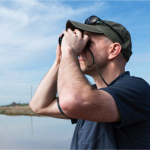 Five and a half million ducks, geese, swans, and shorebirds migrate through California’s Central Valley each year, but they are struggling. In the Central Valley, 95% of shorebird habitat has been lost to development, leaving just 5% to support the entire population on their journey.
Five and a half million ducks, geese, swans, and shorebirds migrate through California’s Central Valley each year, but they are struggling. In the Central Valley, 95% of shorebird habitat has been lost to development, leaving just 5% to support the entire population on their journey.
The Nature Conservancy has taken an innovative approach to solving this problem. The Central Valley is full of rice fields, and flooded rice fields actually make great shorebird habitat! But it takes work for the farmers to maintain the very specific water depth that the birds need. So twice a year, TNC runs a reverse auction. Rice farmers in the Central Valley bid to get paid to flood their rice fields during critical migration periods. TNC chooses farms and fields to maximize the amount of habitat they can create each migration season with their limited resources.
Once the farmer has a contract, they need to maintain the required water levels, or they don’t get paid. Field technicians from TNC visit each farm periodically throughout the contract to monitor water levels and estimate the number of birds in the fields.
Problem
In the first year of this program, water level data was gathered into a mobile form and pushed through a series of spreadsheets, subject to lots of time-intensive manual processes and calculations. If there was an issue in a field, it often took 1-2 days until a program manager had enough information to be able to call the farmer to follow up and resolve the issue. In a 2-week contract, a 2-day delay is significant! While TNC makes extensive use of Salesforce to track other areas of their work, all of this field compliance process was outside of Salesforce.
Solution
This year, The Nature Conservancy won a Salesforce Foundation Force for Change grant to improve this process. We worked with TNC to implement an end to end process in Salesforce that enables them to be more efficient, in turn letting them work with more farmers and ultimately support more shorebirds. Here’s how it works:
Program Managers first configure the compliance requirements for a contract period in Salesforce:

Each farmer contract is connected to one of these Program Period records:

To track contract compliance, numbered stakes are placed in the fields under contract. The stakes are color banded to indicate water depth:

Field techs perform frequent site visits during the contract period to ensure the field’s water levels are in compliance. The techs use Salesforce1 on their mobile devices to enter water level data for each stake directly into Salesforce in real time:

Field techs also report their overall impression of flooding on the rice fields:

Their reports are automatically compared against the depth requirements for that particular contract period, and the field’s rate of compliance is automatically calculated:

If a field is at all out of compliance, program managers immediately get a notification email with the details of the field report and the farmer’s contact information. This enables them to pick up the phone right away to talk with the farmer and work together to resolve the issue and bring the field back into compliance as quickly as possible.
At the end of the contract period, the payment amount, pro-rated by compliance, is automatically calculated:

At each step of the process, managers can also manually override the compliance rate if they feel the farmer has made a good-faith effort to maintain water levels:

And that’s what it took to replace a cumbersome set of spreadsheets and web forms. This new system allowed TNC to further centralize their work in Salesforce and leverage the mobile capabilities of Salesforce1 for their field techs. As a result, they are more efficient in their day to day work, shortening their feedback loop with farmers. This has improved field compliance, providing better habitats for migratory birds.
Photos courtesy of The Nature Conservancy.